
|
Sale 99
The July 8-9, 2017 Manuscript, Space, Collectibles & Stamp Auction
| Lot |
Photo |
Description |
Realized |
Lot 717 |
 |
Large Sinohydorsaurus. Sinohydrosaurus lingyuanensisgen was a strange looking aquatic reptile with a very long neck that lived 150 million years ago in fresh water lakes in Liaoning Province, China. Sinohydrosaurus translates to "Chinese water dragon." This large specimen is over 21" long and virtually complete (missing only a few digits and claws from the feet) with all four legs, tiny rib bones and even smaller gastralia rib bones and skull with some teeth and some bones that are disacticulated. This superbly detailed reptile is wonderfully preserved in the same position that it was buried 150 million years ago on a 26 x 9" matrix of soft tuffaceous volcanic rock. Estimate Value $3,000 - 4,000
View details and enlarged photo
| Unsold |
Lot 718 |
 |
Impressive and Complete Cave Bear Skull - Ursus Spelaeus. The Cave Bear lived in Europe during the Pleistocene period, becoming extinct at around the time Cro Magnon man appeared, some 27,500 years ago. This specimen comes from Romania with original paired jaws. The male cave bear grew to 10 feet or more in length, and weighed up to a ton (2000 pounds). The skull is 8½ in. in height, approximately 16 in. in length, and 7½ in. across. A fine specimen and displays beautifully. Estimate Value $3,000 - UP
View details and enlarged photo
| Realized
$2,400 |
Lot 719 |
 |
Partial Lizard in 100-Million-Year-Old Amber. One of the rarest and most desirable of creatures in amber is the lizard. This remarkable 15 mm long lizard foot is encased in a 15 x 10 mm translucent orange 100-million-year-old Burmite amber nugget that clearly shows the lizard foot with a long extended fourth toe, a couple of small insects, and a small twig that the foot appears to be grasping. This unusual lizard foot is very similar to that of the living green Basilisk lizard, which has a similarly extended fourth toe and can walk on water thanks to the webbing between its toes. Estimate Value $2,000 - 2,750
View details and enlarged photo
| Unsold |
Lot 720 |
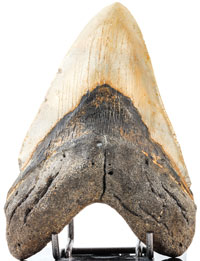 |
Huge Megalodon Shark�s Tooth. Carcharodon megalodon was the largest shark that ever lived, growing to more than 50' in length and eating whales whose bones are found right alongside the huge teeth of megalodon. This immense 6¼" on the diagonal 4" wide 15-20-million-year-old Carcharodon tooth was found in the muddy river waters of South Carolina. This huge tooth has lovely light tan with grey toned enamel with very good serrations. There are a few small nicks in the serrations, as well as one crack in the enamel on the flat side. The black root is complete, except for a small chip in the upper right corner. There is no restoration on this huge tooth. Estimate Value $2,000 - 3,000
View details and enlarged photo
| Realized
$2,100 |
Lot 721 |
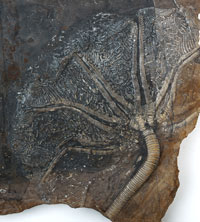 |
Museum Quality Giant Crinoid. The Crinoid, which is known as a "sea lily", is actually an echinoderm with five-fold symmetry related to the star fish. This museum quality 17½ x 16" gray stone slab contains a 23", 240-million-year-old Traomatocrinus crinoid from the Guizhou Province of China. This giant crinoid consists of a 16" wide and 8" long Calyx (cup or flower part) with a 7" long stem. The detail is excellent, with many of the fine feather-like pinnules visible. These sieve-like pinnules were used to capture small prey, which were transported to the mouth at the center of the Calyx. This striking crinoid, positively Giger-esque in its appearance, has no restoration and is a light gray color which contrasts nicely with the dark gray matrix. Estimate Value $2,000 - 2,500
View details and enlarged photo
| Unsold |
Lot 722 |
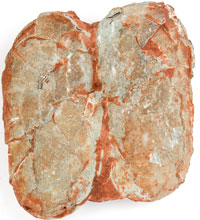 |
Pair of Unhatched Oviraptor Eggs. These two complete Oviraptor eggs are 70-80-million-years-old from the Gobi desert and measure 6½ x 3" and 6¼ x 3", belonging to the largest of the two Oviraptor species called Citipati. Citipati eggs are ratite in texture and have a very thin shell, making it rare to find them complete. This quality pair of eggs has been compressed a little with excellent texture and about 90% original shell on one egg and 75% shell on the other egg. The shell is a medium gray color with a small section of reddish brown matrix connecting the two eggs. Estimate Value $2,000 - 2,750
View details and enlarged photo
| Unsold |
Lot 723 |
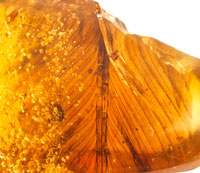 |
Possible Dinosaur Feather in Amber. This 8 x 10 mm clear partial feather, beautifully preserved in a 16 x 5 mm polished cabochon of honey colored Burmite amber, could belong to an early bird or theropod dinosaur. The distinctions between dinosaurs and early birds are somewhat blurred, but both Coelerasaurs and Tyrannosaurs are known to have been feathered from important fossils found in China. This branching feather has excellent detail and is symmetrical on both sides of the central rachis, which means that it is not a flight feather but rather a body, tail, or neck feather. Most amber is too young to have dinosaur feathers trapped in it, but this Burmite exemplar, found in the Hukawang Valley of northern Burma (Myanmar), is 100 million years old, sufficiently aged to capture such a remarkable specimen. Estimate Value $1,500 - 2,000
View details and enlarged photo
| Unsold |
Lot 724 |
 |
Mastatadon Femur, Lower to Middle Pleistocene Era. Mammut Americanum, American Mastadon from the Lower to Pleistocene Era. The Irvingtonian North American Land Mammal Age (NALMA) on the geologic timescale is the North American faunal stage, typically set from 1,800,000 to 240,000 years BP, a period of 1.56 million years. In quite fine condition, this is a compelling example meausuring at 39 inhes in length, about 12 inches high, 8 inches in thickness at the largest end and weighs about 40 pounds. Decades old restoration to to secure a split and some pitting on the end, but otherwise a phenomenally appealing specimen. Excavated years ago from the Leisey Shell Pit in Ruskin Florida. The pit was discovered was discovered in July 1983 by Frank Garcia. and proved to be an extremely rich concentration of medium and large-sized terrestrial vertebrates. Mining and fossil collecting at the Leisey Shell Pits sites has permanently ceased and remain in private hands. Conveys with custom wood and iron tabletop display and brass identification plaque.
Domestic shipping only. Overseas purchasers would require the services of a third-party shipper which we can recommend. Estimate Value $1,000 - 1,500
View details and enlarged photo
| Unsold |
Lot 725 |
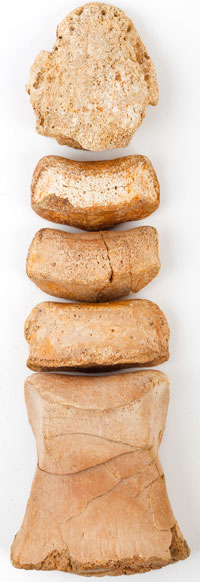 |
Complete Large Duckbill Dinosaur Toe. This large 11" long outer toe (Digit 4) of the famous Duckbill Dinosaur Edmontosaurus, which had only three toes on its hind feet, is complete with just minor crack repairs on two of the phalanges and a chip on the hoof (ungual). Found on a private ranch in the 66-67-million-year-old Hell Creek Formation of Montana, the hoof is 3¼" long and 3" wide, which in life would have had webbed skin attached to its base, hence the name Duckbill dinosaur. Estimate Value $800 - 1,000
View details and enlarged photo
| Realized
$528 |
Lot 726 |
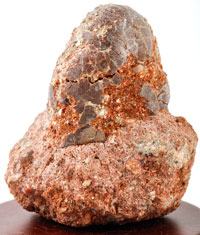 |
Rare Toodon Dinosaur Egg. Troodon was a small predatory dinosaur, about 6' long, with long slender limbs and the largest brain for a dinosaur its size. This 2" long 1½" wide, dark brown Troodon egg is 70-80 million years old and hails from the Gobi desert in Asia. This rare Troodon egg has just over 70% of its original shell, a loss typical of these remarkably thin eggshells which, at just 1mm thick, do not preserve very well. Troodon eggs are hundreds of times rarer than hadrosaur eggs, because Troodon was a theropod dinosaur, laying its eggs in individual nests rather than groups. Estimate Value $700 - 900
View details and enlarged photo
| Realized
$810 |
Lot 727 |
 |
Pair of Russian Trilobites. The first of our pair is a complete enrolled 2" Neoasaphus kowalewski, a very strange looking trilobite with extremely long, 1" eyestalks, from the Wolchow river near St. Petersburg, Russia. The second trilobite is a dark brown 3½" long Neoasaphus trilobite, with more normal sized compound eyes. Estimate Value $600 - 800
View details and enlarged photo
| Unsold |
Lot 728 |
 |
Carcharodon Tooth With Scrimshaw Diorama. This 4¼" on the diagonal and 3½" wide 15-20-million-year-old Carcharodon tooth was found in a deep water location (over 1000' deep) north of a small island called New Caledonia. This nearly complete tooth has light beige enamel that has an etched 2 x 1�" scrimshaw diorama of a Carcharodon shark with open jaws. This miniature piece of art is signed and dated by the artist, "Kelly Kennedy 2005", at the bottom of the tooth. A renowned scrimshaw artist, Kennedy died in 2008. Estimate Value $600 - 800
View details and enlarged photo
| Realized
$600 |
Lot 729 |
 |
Large Complete Ammonite with Flashes of Iridescence. This large complete 9½ x 7" ammonite of the Placenticeras species has flashes of bright reddish-orange iridescence preserved on its original mother of pearl shell. When cut, this colorful part of the ammonite shell is used in jewelry and is known officially as ammolite, a registered gemstone. This remarkable ammonite, preserved in a bowling ball type concretion, is from the 75-million-year-old Pierre Shale of South Dakota, when South Dakota was part of the large inland sea. This complete ammonite is still partially contained within part of the concretion which serves as a natural display stand. Estimate Value $600 - 700
View details and enlarged photo
| Unsold |
Lot 730 |
 |
Pair of Fossil Crabs. Archaeoperyon puruvianus was a 25-million-year-old fossil crab from Argentina. This lot includes two large crabs, the largest being 8" and the smaller one 6½" long, side by side as found in their original 14½ x 5" stone matrix. Both crabs have complete carapaces and large claws with shearing teeth-like projections lining the claws and only the ends of some of the legs missing. Estimate Value $500 - 600
View details and enlarged photo
| Unsold |
Lot 731 |
 |
Therizinosaur Dinosaur Egg. This rare dinosaur egg is distinctive as it comes from the enigmatic class of feathered theropod dinosaur known as the Therizinosaur, a creature characterized by its small skull, long neck, large hand claws, and full body that lived some 80-90 million years ago in Asia. Therizinosaur eggs have thin shells and come in various sizes depending on which species deposited the eggs. This partially crushed 4 x 3½" brown and gray egg is in good condition: it is unhatched, with over 80% of its original shell on the top side and some shell fragments on the bottom side. Estimate Value $500 - 600
View details and enlarged photo
| Realized
$600 |
Lot 732 |
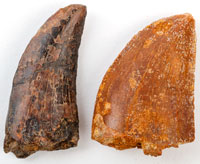 |
Pair of Theropod Dinosaur Teeth. This lot contains similarly sized teeth from two of the largest carnivorous dinosaurs (40-45' long) that ever lived: a dark brown 1�" Juvenile T-Rex from North America and a 1½" Charcharodontosaurus from Africa. The completeT-Rex tooth from Montana has just has the usual cracks in the enamel and some serrations, but no restoration. The complete Charcharodontosaurus tooth from Morocco is a light brown color with most of the enamel intact, good serrations and no restoration. Estimate Value $450 - 600
View details and enlarged photo
| Unsold |
Lot 733 |
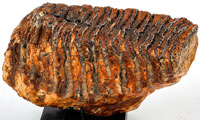 |
Wooly Mammoth Tooth. Wooly Mammoths (Mammuthus primigenius) had the largest individual teeth of any animal that ever lived. This large 8½" long, 3½" wide and 5½" deep molar was dredged from the North Sea and is 30,000 -75,000-years-old. The flat grinding part of the mottled brown tooth has attractive black enamel alternating with a dark brown dentine and a large 5½" dark brown root that is virtually complete except for some of the sharp edges. Estimate Value $450 - 600
View details and enlarged photo
| Realized
$384 |
Lot 734 |
 |
Nice Collection of 10 Fossilized Megalodon Teeth. The largest shark that ever lived on Earth, achieving lengths of more than 50 feet. Teeth found are remarkably small on average. Offered here is a range of fossilized teeth from 1¾ to a nicely sized 4½". All in very good condition exhibiting only minor losses. Estimate Value $400 - 800
View details and enlarged photo
| Realized
$228 |
Lot 735 |
 |
Cave Bear Paw. This complete lower jaw of the huge Ursus spelaeus cave bear is between 20,000-150,000 years old and was found in caves in Romania. The jaw is 10½" long and 4¼" wide, complete with all four large molars and a large 2" canine tooth. Three of the large molars are double molars with two teeth. Estimate Value $400 - 550
View details and enlarged photo
| Unsold |
Lot 736 |
 |
Albertosaurus Dinosaur Tooth. Albertosaurus, a somewhat smaller version of its more famous relative T-Rex, is older than T-Rex at 70-million-years-old and found only in the Judith River Formation of Montana and Canada. This 2¼" brown tooth found in two pieces has complete dark brown enamel with excellent detail that shows several wavy growth ripples somewhat like the growth rings in a tree. There are excellent serrations on the bottom side of the tooth while the top surface is mostly worn, and the enamel shows only several light cracks. Estimate Value $400 - 500
View details and enlarged photo
| Unsold |
Lot 737 |
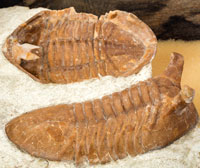 |
Unusual Pair of Trilobites. This unusual display of two 3D prepped Neoasaphus kuthkowi trilobites includes a 3½" dark brown specimen with eye stalks plus a 3" specimen that has been prepared upside down to show its mouth part known as a hyposome in high relief. These spectacular 450-million-year-old trilobites, found near the Wochow River Southwest of St. Petersberg, Russia are beautifully displayed in their original 7 x 4½" stone matrix. Estimate Value $400 - 600
View details and enlarged photo
| Unsold |
Lot 738 |
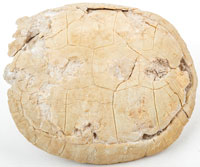 |
Fossil Badlands Turtle with Bite Marks. Stylemys nebrascensis is a 30-million-year-old tortoise that roamed the White River Formation of the South Dakota Badlands. This near complete specimen measures 7 x 6" and is well preserved with bite marks from some sharp-toothed predator: there are three bite marks on the top of the shell and another bite mark on the tortoise's bony underside, its plastron. Most of the plastron is preserved, along with a 1½" leg bone and other bones still clearly buried in the matrix. Estimate Value $400 - 600
View details and enlarged photo
| Realized
$250 |
Lot 739 |
 |
Unusual Russian Trilobite. Illaenus tauricornis was a strange looking trilobite with curved spines extending from the ends of its cephalon (head) reminiscent of a handlebar moustache. It crawled across the warm ocean floor 450 million years ago in the Wolchow river near St. Petersburg, Russia. This complete brown trilobite is 2¾" long on a 6½ x 5" light gray limestone matrix. Estimate Value $400 - 525
View details and enlarged photo
| Unsold |
Lot 740 |
 |
Dinosaur Tail Vertebrae. Edmontosaurus was one of the largest of the Duck Billed dinosaurs and a favorite food item for T-Rex. This huge 66-67-million-year-old tail vertebrae from an adult Edmontosaurus was found in the Hell Creek Formation of South Dakota, measures 13 x 8½", and weighs 6½ lbs. The large tail vertebrae has its central hole that contained nerves and blood vessels, as well as the side processes, where tail muscles attached. Estimate Value $400 - 500
View details and enlarged photo
| Unsold |
Lot 741 |
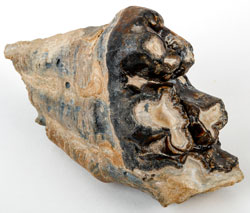 |
Nice Example of Fossilized Mastadon Teeth, Piocen to Late Pleistocene Period. Nice example of fossilized mastadon teeth. A mastodon, like all proboscideans, has a system of horizontal tooth replacement whereby new molars erupt from the rear of the jaw and move forward. The most worn teeth at the front, are pushed out of the jaw. When they reached senior years no more teeth were created. This gradual inability to eat due to the worn remaining molars caused the animal to die from starvation. This actually remains true with the modern day elephant. This specimen 6 x 5 x 3" and is in great condition for display. Estimate Value $300 - 400
View details and enlarged photo
| Realized
$188 |
Lot 742 |
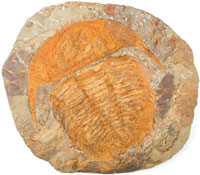 |
Gigantic Trilobite. More than 500 million years old, Paradoxides was one of the earliest trilobites that ever lived. This gigantic 11½" long and 11" wide, virtually complete trilobite was one of the largest predators of the mid Cambrian warm seas of Morocco. Found in the Atlas Mountain range of Morocco, this trilobite has an attractive rust brown-orange color formed from limonite (an iron oxide), which nicely contrasts the 17 x 15½" dark gray matrix. There is only minor restoration on the tips of the spines on the pygidium. Estimate Value $300 - 400
View details and enlarged photo
| Unsold |
Lot 743 |
 |
Collection Of Fossilized Shark, Fish AND Mosasaur Teeth. This collection of over 85 45-70-million-year-old Shark, Stingray, fish and mosasaur teeth comes from the Moroccan Phosphate mines of Khouribga. There are 25 different species of teeth from 2-5" in this collection, all mounted and labeled by species in a custom wooden case measuring 19 x 11½". Estimate Value $300 - 400
View details and enlarged photo
| Realized
$384 |
Lot 744 |
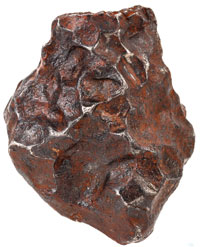 |
Mass Mortality Trilobite Plate. This large 15 x 10" 375-million-year-old slab from Alnif, Morocco, is covered with dozens of complete 1" Phacops trilobites and dozens of partial trilobites. The most likely reason for such a mortality plate is sudden death during mating, or perhaps a group of Trilobites molting. Please note that our photograph is a detailed view of just one section of the larger piece. Estimate Value $300 - 400
View details and enlarged photo
| Unsold |
Lot 745 |
 |
Complete Unusual Crotalocephalus Trilobite. There are many different types of trilobites found at the 375-million-year-old rock of Lamrakeb, Alnif, Morocco. Crotalocephalus has a unique appearance, being longer and thinner than most trilobites. This 2¾ x 1" black trilobite is complete and has been expertly prepared in a natural 3-D position, sitting on top of a 3 x 1½" limestone base. It has been prepared and even shows its mouth (hypostome) beneath its head. Estimate Value $250 - 350
View details and enlarged photo
| Realized
$276 |
Lot 746 |
 |
Three Fish and a Branch. From the famous dry 52-million-year-old lake beds of Green River, Wyoming, this large 19 x 13" limestone plate contains three Knightias and a 1' long twig from an unidentified tree. The twig is quite rare, as plants are rarely found with the more common fish. The largest Knightia is 4" long and excellent and the two small
complete Knightias are each 1¾" long. Estimate Value $250 - 350
View details and enlarged photo
| Unsold |
Lot 747 |
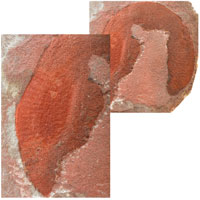 |
The Enigmatic Eldonia. Eldonia is a discoidal, soft-bodied animal of unknown affinities (i.e., it is not a jellyfish). It has a mouth and anus opening on the bottom of the disc with short tentacles around its mouth. This 415-million-year-old mystery animal found in Alnif, Morocco, is 7 x 6½" with ripple-like segments radiating from its center. It is dark brown against a 10 x 8" dark gray matrix and still has some of the gray stone matrix attached to the bottom center of the fossil. Estimate Value $200 - 300
View details and enlarged photo
| Unsold |
|
|